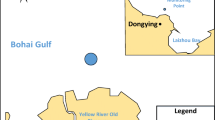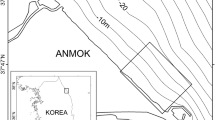Abstract
Water movement is probably the most important factor influencing life in the interstices of sandy beaches. In order to better understand this ecosystem, e.g. the distribution and migration of interstitial fauna and overall energy transfer, measurements of water flow through high energy beaches were made on the Atlantic coast of the USA. Special hot thermistor-probes and associated electronic circuits were built, capable of measuring water-flow velocity down to less than 10 μm/sec. These were buried in the sand at various depths and locations in the intertidal zone and the flow velocity recorded continuously for one or more tidal cycles. In addition, an orientation sensor was constructed and used together with the flow probe so that a picture of the flow patterns in the intertidal zone of a beach and their changes during a tidal pattern could be developed and defined quantitatively.
Similar content being viewed by others
Literature cited
Bruce, J. R.: Physical factors on the sandy beach. Part I. Tidal, climatic and edaphic. J. mar. Biol. Ass. U.K. 15, 535–552 (1928).
Childs, E. and A. Poulovassilis: The moisture profile above a moving water table. J. Soil Sci. 13, 271–285 (1962).
De Wiest, R.: Flow through porous media, 330 pp. New York: Academic Press 1969.
Eagleson, P. S. and W. P. van de Watering: A thermistor probe for measuring particle orbital speed in water waves. Tech. Memor. U.S. Army cstl Engng Res. Center, Washington, D. C. 3, 1–44 (1964).
Emery, K. O. and J. F. Foster: Water tables in marine beaches. J. mar. Res. 7, 644–654 (1948).
Fenchel, T. M. and R. J. Riedl: The sulfide system; a new biotic community underneath the oxidized layer of marine sand bottoms. Mar. Biol. 7, 255–268 (1970).
Forstner, H. and K. Ruetzler: Two temperature-compensated thermistor current meters for use in marine ecology. J. mar. Res. 27, 263–271 (1969).
Grant, U. S.: Influence of the water table on beach aggradation and degradation. J. mar. Res. 7, 655–660 (1948).
Hahn, H.: Thermistoren, 118 pp. Berlin: Decker's Verlag 1965.
Harrison, W.: Empirical equations for foreshore changes over a tidal cycle. Mar. Geol. 7, 529–551 (1969).
Jansson, B.-O.: The significance of grain size and pore water content for the interstitial fauna of sandy beaches. Oikos 18, 311–322 (1967).
Katys, G. P.: Continuous measurement of unsteady flow, 217 pp. New York: MacMillan & Co. 1964.
Lumley, J. L.: The constant temperature hot-thermistor anemometer. In: Symposium on measurement in unsteady flow, pp 75–82. Worcester, Mass.: 1962.
Ott, J.: Studies on the diversity of the nematode fauna in intertidal sediments. 5th Europ. Symp. mar. Biol. (Venice) 1970. (In press).
Perkins, E.: The hardness of the soil of the shore at Whitstable, Kent. J. Ecol. 46, 71–81 (1958).
Prandtl, L.: Essentials of fluid dynamics, 452 pp. London: Blackie & Sons, Ltd. 1966.
Renaud-Debyser, J.: Recherches écologiques sur la faune interstitielle des sables, 157 pp. Paris: Hermann 1961.
Riedl, R.: Marinbiologische Aspekte der Wasserbewegung. Mar. Biol. 4, 62–78 (1969).
—: Water movement: general introduction. In: Marine ecology, Vol. 1. Pt 2. pp 1085–1088. Ed. by O. Kinne. London: John Wiley & Sons 1971a.
—: Water movement: animals. In: Marine ecology, Vol. 1. Pt 2. pp 1123–1149. Ed. by O. Kinne. London: John Wiley & Sons 1971b.
Riedl, R.: How much seawater passes through intertidal interstices? Int. Rev. ges. Hydrobiol. (1971c). (In press).
— and H. Forstner: Wasserbewegung im Mikrobereich des Benthos. Sarsia 34, 163–188 (1968).
—, N. Huang and R. Machan: The subtidal pump, a mechanism of interstitial water exchange by wave action. Mar. Biol. 13, 210–221 (1972).
— and E. MacMahan: High energy beaches In: Coastal ecological systems of the United States, pp 197–269. Ed. by H. T. Odum, B. J. Copeland, and E. A. MacMahan. Washington, D. C.: Federal Water Pollution Control Administration 1969.
— and J. Ott: The suction corer, a device to yield electric potentials in coastal sediment layers. Senckenberg. marit. 2, 67–84 (1971).
Rieger, R. and J. Ott: Gezeitenbedingte Wanderung der Turbellarien und Nematoden eines nordadriatischen Sandstrandes: 3rd Europ. Symp. mar. Biol. (Arcachon) 1968. Vie Milieu (Suppl.) 22, 425–447 (1971).
Saleem, M.: An inexpensive method for determining the direction of natural flow of ground water: J. Hydrol. 9, 73–89 (1969).
Scheidegger, A.: The physics of flow through porous media, 313 pp. New York: MacMillan & Co. 1960.
Schlichting, H.: Boundary layer theory, 747 pp. New York: McGraw-Hill 1968.
Webb, J.: Biologically significant properties of submerged marine sands. Proc. R. Soc. (Ser. B.) 174, 355–402 (1969).
Author information
Authors and Affiliations
Additional information
Communicated by O. Kinne, Hamburg
Rights and permissions
About this article
Cite this article
Riedl, R.J., Machan, R. Hydrodynamic patterns in lotic intertidal sands and their bioclimatological implications. Mar. Biol. 13, 179–209 (1972). https://doi.org/10.1007/BF00391378
Accepted:
Issue Date:
DOI: https://doi.org/10.1007/BF00391378




